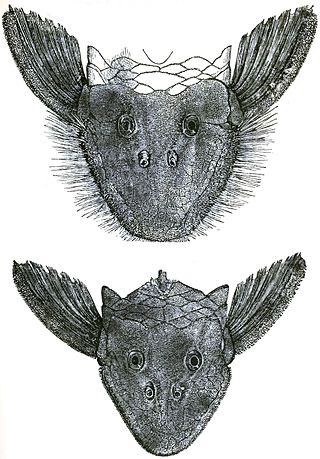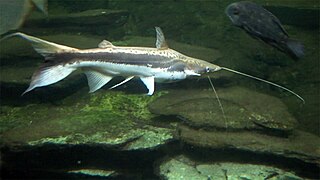
Hypostomus is a genus of catfish in the family Loricariidae. They are native to tropical and subtropical South America. H. plecostomus is the popular freshwater aquarium fish formerly known as Plecostomus plecostomus. The taxonomic structure of the Loricariidae is still being expanded by scientists. Hypostomus is a highly species-rich and widely distributed catfish genus.

Pseudancistrus is a genus of suckermouth armored catfishes native to South America.

Sorubim is a small genus of long-whiskered catfish native to tropical South America. A number of characteristics allows the differentiation of each species in the genus. Sorubim species are important food fish in South America and are highly significant to fisheries of some areas; however, harvests of these fish are not identified as much as other, more popular food fishes such as Colossoma, Arapaima, and Brachyplatystoma. Some species of this family are popular aquarium fish.
Hisonotus is a genus of armored catfishes native to South America. Species of Hisonotus and Curculionichthys are the only representatives of the subfamily Otothyrinae having serrae on the posterior edge of the pectoral fin spine. These species are small fishes, generally found in small fast flowing streams, where they grasp to the branches and leaves of aquatic or subaquatic plants. The species of this genus mostly occur in Atlantic coastal streams of southern Brazil and the Paraguay-Paraná system of southern South America. They are also distributed in the Río de La Plata basin and coastal rivers of southeastern Brazil.
Neoplecostomus is a genus of fish in the family Loricariidae native to South America. Neoplecostomus can be distinguished from all other loricariids by a modified shield of small plates on the abdomen with posteriorly directed odontodes; the shield appears to act as a holdfast. The color pattern is generally mottled brown with the abdomen white. The head is long, rounded, and shovel-shaped. The fin spines are weak. They range from about 8 to 11 cm (3.1–4.3 in) SL. The species of Neoplecostomus live in fast-flowing water.
Pareiorhina is a genus of armored catfishes native to South America where they are only found in Brazil. These species are known to occur at altitudes above 650 metres (2100 ft) in various rivers of the Grande, Paraíba do Sul, São Francisco and Tietê River basins. This genus was first erected by Gosline in 1947 as a monotypic genus to include Rhinelepis rudolphi. It was not until 2003 that a second species, P. carrancas, was described. The third species, P. brachyrhyncha was described in 2005. Pareiorhina forms a monophyletic subunit with Neoplecostomus within the subfamily Neoplecostominae.

Magosternarchus is a genus of weakly electric knifefish in the family Apteronotidae, containing two species. They are endemic to Brazil, occurring in large river channels in the Amazon River basin. Both species are unusual benthic predators that specialize in biting off the tails of other knifefishes, and are characterized by their greatly enlarged jaws and teeth. Recent systematic studies indicate that both species should be included in Sternarchella instead of being placed in their own genus.
Curculionichthys is a genus of fish in the family Loricariidae native to South America.
Galaxias oliros, the obscure galaxias, is a galaxiid of the genus Galaxias, a member of the Mountain Galaxias species complex group of freshwater fish, found in Australia.
Curculionichthys coxipone is a species of catfish in the family Loricariidae. It is native to South America, where it occurs in the drainage basins of the Cuiabá River and the Paraguay River. It reaches 3 cm SL. The species was described in 2015 by Fábio Fernandes Roxo, Gabriel Souza da Costa e Silva, Luz E. Orrego, and Claudio Oliveira, alongside the description of the genus Curculionichthys to include several species formerly classified in the genus Hisonotus.

Curculionichthys insperatus is a species of catfish in the family Loricariidae. It is native to the Paraná River drainage in Brazil, where it inhabits streams near banks covered with partially submerged vegetation. It reaches 3 cm SL. This species was formerly classified as a member of the genus Hisonotus, although it was moved to the then-new genus Curculionichthys in 2015.
Curculionichthys sabaji is a species of catfish in the family Loricariidae. It is native to the Xingu River basin in Brazil. The species reaches 2.4 cm SL. It was described in 2015 by Fábio Fernandes Roxo, Gabriel Souza da Costa e Silva, Luz E. Orrego, and Claudio Oliveira, alongside the description of the genus Curculionichthys to include several species formerly classified in the genus Hisonotus.
Curculionichthys sagarana is a species of catfish in the family Loricariidae. It is native to South America, where it occurs in the drainage basins of the Das Velhas River and the São Francisco River. It reaches 2.4 cm SL. The species was described in 2015 by Fábio Fernandes Roxo, Gabriel Souza da Costa e Silva, Luz E. Orrego, and Claudio Oliveira, alongside the description of the genus Curculionichthys to include several species formerly classified in the genus Hisonotus.
Hisonotus vespuccii is a species of catfish in the family Loricariidae. It is a freshwater species native to South America where it occurs in the São Francisco River and three of its tributaries: the Das Velhas River, the Paraopeba River, and the Formoso River. It is found in areas with marginal vegetation and reaches 3.6 cm (1.4 in) SL. The species was named after the Italian explorer Amerigo Vespucci.
Parotocinclus dani is a species of catfish in the family Loricariidae. It is native to South America, where it occurs in tributaries of the Tapajós basin in Brazil.
Pseudancistrus asurini is a species of catfish in the family Loricariidae. It is native to South America, where it occurs in the Xingu River basin in the state of Pará in Brazil. The species reaches 19.6 cm SL. Its specific epithet, asurini, refers to the Asurini people, native speakers of the Xingu Asurini language, who inhabit the Xingu basin near Altamira. It was described in 2015 by Gabriel S. C. Silva, Fábio F. Roxo, and Claudio Oliveira alongside the related species Pseudancistrus kayabi from the Tapajós basin.
Pseudancistrus kayabi is a species of catfish in the family Loricariidae. It is native to South America, where it occurs in the Teles Pires River, which is part of the Tapajós basin in the state of Mato Grosso in Brazil. The species reaches 8.8 cm SL. Its specific epithet, kayabi, refers to the Kayabí people who historically inhabited the region surrounding the Teles Pires, Arinos, and Dos Peixes river basins in Mato Grosso. It was described in 2015 by Gabriel S. C. Silva, Fábio F. Roxo, and Claudio Oliveira alongside the related species Pseudancistrus asurini from the Xingu River basin.
Bryconops allisoni is a species of freshwater fish known from the rivers of Brazil. It is a recent addition to the genus (2019), currently considered a member incertae sedis. Its name honors Antonio Machado-Allison, an ichthyologist responsible for a great deal of work on the genus Bryconops.
Bryconops chernoffi is a species of freshwater fish that inhabits the rivers of Brazil. Specifically, it is found in the Rio Maicuru and Rio Ipixuna; the latter is a tributary of the former, which is a tributary of the Amazon river main. B. chernoffi demonstrates a preference for clear-water streams with sandy and rocky bottoms.
Bryconops rheoruber is a species of freshwater fish from the rivers of Brazil. Its back scales are tan-to-cream, and its belly is silvery; the divide between the two colors is marked by a broad iridescent-silver stripe. Its fins are a mixture of pale, clear, and reddish, which contributed to its specific name. "Rheo" means "flow" or "current" in Greek, and "ruber" means "red" in Latin.







